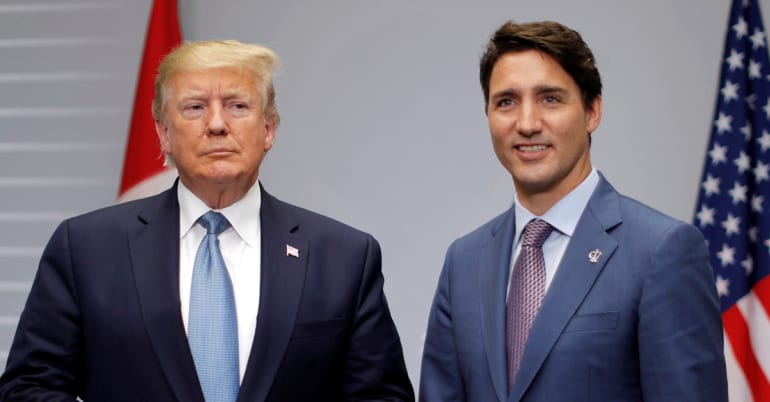Two topics are front-of-mind for many investors right now. First, gains by non-US technology stocks are challenging the dominance of the Magnificent 7 in recent years. Second, the trade war breaking out as the Trump administration attempts to reduce the US trade deficit. For good reason, the latter is dominating economists’ workflow as they address the gap between the perception and the reality of the impacts of higher US trade levies.
The perception is simple: if the US imposes tariffs on American imports, these will become more expensive for domestic consumers and businesses, increasing inflation. Yet in 2018, tariffs did not impact official inflation figures (something the Trump administration hasn’t failed to point out). There are two ways to approach this debate: we can analyse history to understand if, in general, increased tariffs systematically lead to inflation; and we can look at the details of how the Trump administration previously implemented tariffs.
In the first of a two-part series on this topic, we explore the use of tariffs in the past 125 years.
A brief history of tariffs
In the late 18th century, an experiment with tariffs not dissimilar to the one being planned now took place in the US. At the time, the US was on the brink of industrialisation and railroad construction, and Europe’s technological advancement weighed on American industry. As a result, Republicans sought to impose significant tariffs on imports – particularly from Europe – and 10% tariffs at the beginning of the 19th century climbed to more than 50% by mid-century.
The Republicans favoured tariffs over taxation, as they were concerned that direct taxes would harm the budding American economy. Collecting revenue from trading partners instead was seen as a way to shift the tax burden toward consumers and foreign companies. This double effect was central to the drafting of the Tariff Act of 1789. The effect was substantial: nearly 90% of US Treasury receipts came from these tariffs. They remained until the end of the 19th century. The Democratic administration under Woodrow Wilson upended the tariff regime with the Underwood Act in 1913.
Figure 1 shows the evolution of implemented tariffs since 1900 in the US, UK and France, allowing for a historical comparison between these three developed economies over time. As can be seen, the three countries haven't experienced a marked increase in tariffs since the 1950s. Once implemented, President Trump's 2018 tariffs only led to a 2% increase in the level of effective tariffs, which partially explains their subdued impact on domestic inflation at the time.
Read also: Trump’s tariffs: inflationary after all?
However, there is one period that shows a more marked and simultaneous increase in tariffs. During the 1930s, US tariffs increased from 5% to 20% (with even higher figures for a subset of imported products). This led both France and the UK to respond decisively. President Roosevelt eventually reversed course as part of his New Deal, returning to the path of free trade against the backdrop of what would later become the General Agreement on Tariffs and Trade, the multinational consensus that led to the formation of the World Trade Organisation. This phase of economic history seemed to have been well and truly established, until 2018.
FIG 1. Effective tariffs between the US, UK and France, 1900-20241
What about inflation?
What can this history of tariffs teach us about how the levies influence inflation? Furthermore, can we differentiate between the impacts of a unilateral tariff increase and a series of multilateral increases – i.e. a real trade war? Figure 2 estimates the effect on US inflation from these situations, isolating both the immediate response to tariff increases (on a yearly scale) and the future inflation response.
FIG 2. How US inflation responded to tariff increases, 1900-20242
Read also: Higher US tariffs: winners and losers
In our view, the key conclusions from this analysis are:
- A small increase in tariffs of about 1-2% (close to the level implemented in 2018) produces a similar inflationary effect. But if this triggers reciprocal tariffs from trading partners, the inflationary effect is either attenuated (if the response comes the following year) or cancelled out (if it is immediate). In all cases, this is a short-term effect, as shown in Figure 2B
- A larger increase in tariffs beyond 2% has historically led to a decrease in inflation, both in the year of implementation and in the three years that followed. Inflation declines on average by 1% in the initial 12 months and by more than 3% in the following years.
A crucial point is that beyond a certain level, tariffs tend to become recessionary, pushing inflation down in the wake of deteriorating growth. This effect is even more pronounced when tariffs become reciprocal in a trade war. Christine Lagarde, President of the European Central Bank, has warned leaders not to go down this path. As we know all too well from the 1930s experience, the real risk of withdrawing from free trade is recession.
What this means for All Roads
For us, maintaining a balanced allocation across asset classes makes sense as geopolitical and nominal uncertainty continues amid positive equity and commodities trends. Our market exposure remains at a steady level of 150% for our Balanced solution. We maintain a 60% allocation to diversifying assets and 40% to cyclical assets.
Simply put, history tells us the inflationary effect of tariffs could fast mutate into a recessionary scenario – if they are significant and become reciprocal.
To learn more about our All Roads multi-asset strategy, click here. Macro/nowcasting corner
The most recent evolution of our proprietary nowcasting indicators for global growth, global inflation surprises, and global monetary policy surprises are designed to track the recent progression of macroeconomic factors driving the markets.
Our nowcasting indicators currently show:
- This week, growth marginally improved due to progress in the eurozone and a decrease in data from the US and China. Consumption in the eurozone showed improvement. However, the US is struggling with its manufacturing sector
- Our inflation indicator declined again this week amid slightly deteriorating data and remains above the 50% threshold
- Our world monetary policy nowcaster decreased due to negative indicators in the eurozone and China, while it rose in the US.
World growth nowcaster: long-term (left) and recent evolution (right)
World inflation nowcaster: long-term (left) and recent evolution (right)
World monetary policy nowcaster: long-term (left) and recent evolution (right)
Reading note: LOIM’s nowcasting indicator gathers economic indicators in a point-in-time manner in order to measure the likelihood of a given macro risk – growth, inflation surprises and monetary policy surprises. The nowcaster varies between 0% (low growth, low inflation surprises and dovish monetary policy) and 100% (high growth, high inflation surprises and hawkish monetary policy).










